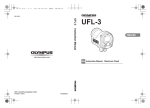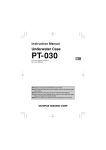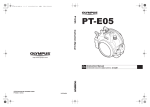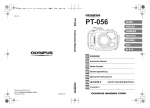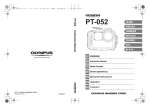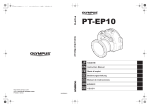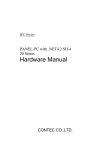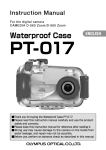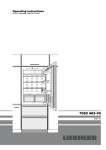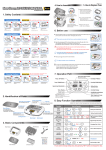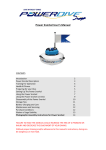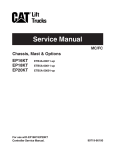Download UFL-1 Instruction Manual
Transcript
UFL-1_1-4.fm Page 1 Friday, February 23, 2007 4:50 PM UFL-1 Instruction Manual http://www.olympus.com/ ©2007 Printed in China VS061801 UFL-1 UFL-1_EN.book Page 2 Tuesday, February 20, 2007 6:09 PM Thank you for purchasing an Olympus product. Please read this instruction manual carefully and use the product safely and correctly. Please keep this instruction manual for reference after reading it. Introduction EN z Unauthorized copying of this manual in part or in full, except for private use, is prohibited. Unauthorized reproduction is strictly prohibited. z OLYMPUS IMAGING CORP. shall not be responsible in any way for lost profits or any claims by third parties in case of any damage occurring from unsuitable use of this product. z OLYMPUS IMAGING CORP. shall not be responsible for damage, lost profits, etc., caused by loss of image data because of defects, disassembly, repair or modification of this product by people other than third parties specified by OLYMPUS IMAGING CORP. or for other reasons. z OLYMPUS IMAGING CORP. reserves the right to alter the features and contents of this publication without obligation or advance notice. For the latest information of product name and numbers etc., please contact your local service station. z If you have any queries regarding this manual, please contact your local service station. Please read the following items before use This product is a precision device designed for use at a water depth within 40 m. Please handle it with sufficient care. z Please read this instruction manual on handling and carrying out the system check as well as care, maintenance and storage of this product. z OLYMPUS IMAGING CORP. shall in no way be responsible for accidents involving immersion of the flash. Any expenses incurred for damage of internal materials or loss of recorded contents caused by immersion of the flash will not be compensated. z OLYMPUS IMAGING CORP. shall not pay any compensation for accidents (injuries or material damage) that may occur during the use of this product. EN 2 UFL-1_EN.book Page 3 Tuesday, February 20, 2007 6:09 PM SAFETY PRECAUTIONS This instruction manual uses a variety of common symbols and icons to assist you in proper handling and usage of this product properly, and to warn you of potential hazards to yourself and others as well as to property. An exclamation mark enclosed in a triangle alerts you to important operating and maintenance instructions in the documentation provided with the product. DANGER If the product is used without observing the information given under this symbol, serious injury or death may result. WARNING If the product is used without observing the information given under this symbol, injury or death may result. CAUTION If the product is used without observing the information given under this symbol, minor personal injury, damage to the equipment, or loss of valuable data may result. EN For customers in Europe “CE” mark indicates that this product complies with the European requirements for safety, health, environment and customer protection. “CE” mark cameras are intended for sales in Europe. This symbol [crossed-out wheeled bin WEEE Annex IV] indicates separate collection of waste electrical and electronic equipment in the EU countries. Please do not throw the equipment into the domestic refuse. Please use the return and collection systems available in your country for the disposal of this product. For customers in USA FCC Notice This device complies with part 15 of the FCC rules. Operation is subject to the following two conditions: (1) This device may not cause harmful interference, and (2) this device must accept any interference received, including interference that may cause undesired operation. Any unauthorized changes or modifications to this equipment would void the user’s authority to operate. For customers in CANADA This Class B digital apparatus complies with Canadian ICES-003. CAUTION z This product is fitted with a high voltage circuit. Never dismantle or modify it. It may cause burns by a short circuit. z Do not use this product in places with the risk of combustible and explosive gas present in the air. It may cause a fire or an explosion. z Do not use the flash pointing to the driver etc. It may cause a serious accident. EN 3 UFL-1_EN.book Page 4 Tuesday, February 20, 2007 6:09 PM WARNING EN z Never use the flash in front of the eyes especially for infants or children within 1 m. It may cause permanent vision impairment, etc. z Keep the flash and batteries out of the reach of infants and children. There is the possibility of the occurrence of the following types of accidents: • Swallowing of small parts. Please consult a physician immediately if any parts have been swallowed. • Triggering of the flash in front of the eyes may cause permanent vision impairment etc. • Injury from parts of the body getting caught in parts which open and close. z If the following cases occur regardless of use on land or underwater*, stop using it and turn off the power then remove the batteries immediately. Please consult your local service station or dealer: • If water or foreign objects come into contact with the electronic flash inside. • If water penetration can be seen on the inside of the flash. • If the product is in some way broken or internally exposed do not touch it under any circumstances. Regardless of the batteries being inserted, there is the possibility of an electrical shock by a short circuit. * When using in water, come to the surface as fast as possible, however, keeping in mind the needed time to come to the surface and the necessary decompression time, wipe the body of any water and take out the batteries. z Do not store the flash in locations with high humidity or dust and much dust. It may cause a fire or an electrical shock. z Do not use the flash when covering the light-emitting part with an easily burnable item, such as a handkerchief. z Do not touch the light-emitting part with your hand soon after the continuous emission. It may cause burns. z The grease for silicone O-ring for this product is not edible. CAUTION z If a bad smell, abnormal noise, deformation or smoke occurs stop use immediately, turn off the power, and remove the batteries. Be careful when removing the batteries as they may be hot. Contact your local service station or dealer before using the product, as it may cause a fire or burns. EN 4 UFL-1_EN.book Page 5 Tuesday, February 20, 2007 6:09 PM z Do not place this product at locations with abnormally high or abnormally low temperatures or at locations with extreme temperature changes. The product may deteriorate or may cause a fire. z Do not alter the battery compartment or try to insert any foreign objects into it. z Do not store the flash at the locations subject to vibrations. It may cause malfunction. z Opening and closing at locations with sand, dust, or dirt may impair the waterproof characteristic and cause water leakage. This should be avoided. z This product has been designed and manufactured for use at a water depth within 40 m. Please note that diving at depths in excess of 40 m may cause deformation or damage to this product. In this case, water penetration may occur. z Rough handling, such as jumping into the water with the flash in your hand or in an outside pocket or throwing the flash into the water could lead to water penetration. Please always take care when handing it from hand to hand etc. z Before traveling by air, please make sure to remove the O-ring, otherwise the difference in air pressure may make it impossible to open the flash. EN Battery handling precautions Follow these important guidelines to prevent batteries from leaking, overheating, burning, exploding, or causing electrical shocks or burns. DANGER z Never heat or incinerate batteries. It could cause a fire or an explosion etc. z Never contact terminals (+) and (-) with metal. z Take precautions when carrying or storing batteries to prevent them from coming into contact with any metal objects such as jewelry, pins, etc. It may cause burns and an injury by short circuit. z Never store batteries where they will be exposed to direct sunlight, or subjected to high temperatures in a hot vehicle, near a heat source, etc. It may cause burns or an injury by battery fluid leaks, overheating or an explosion. z Do not use solder, transform, modify or dismantle the batteries. There is the risk of destroying the terminal safety valve and the scattering of internal contents. It may cause a fire or an explosion. EN 5 UFL-1_EN.book Page 6 Tuesday, February 20, 2007 6:09 PM z Do not connect the batteries to a power socket or car cigarette lighter. It could cause a fire or an explosion etc. z If battery fluid gets into your eyes, flush your eyes immediately with clear, cold running water and seek medical attention immediately. WARNING EN z Keep batteries dry at all times. z Do not touch the batteries with wet hands. It may cause electrical shocks or malfunctions. z To prevent batteries from leaking, overheating, or causing a fire, explosion or injury: • Use only batteries recommended for use with this product. • Never mix batteries (old and new batteries, charged and uncharged batteries, batteries of different manufacture or capacity, etc.). • Never attempt to charge alkaline or lithium batteries. • Insert the batteries carefully with the correct polarity as described in the operating instructions. Do not insert batteries forcibly into the battery compartment. • Never use batteries if their body is not covered by the insulating sheet or if the sheet is torn, as this may cause fluid leaks, fire, or injury. • Never use batteries if their body is not covered by the insulating sheet or if the sheet is torn even if they are sold as new ones. z The following batteries cannot be used: Batteries whose bodies are Batteries whose - terminals only partially or not at all are raised, but not covered covered by an insulating sheet. by an insulating sheet. Batteries whose terminals are flat and not completely covered by an insulating sheet. (Such batteries cannot be used even if the - terminals are partially covered.) z If NiMH batteries are not charged within the specified time, stop charging them and do not use them. Please read the manual carefully to use the rechargeable batteries. z Do not use batteries if they are cracked or broken. It may cause an explosion or overheating. EN 6 UFL-1_EN.book Page 7 Tuesday, February 20, 2007 6:09 PM z If a battery leaks, becomes discolored or deformed, or becomes abnormal in any other way during operation, stop using it. It may cause a fire or an electrical shock. Please contact your local service station or dealer. z Do not remove batteries immediately after using them. Batteries may become hot during prolonged use, which may cause burns. z If a battery leaks fluid onto your clothing or skin, remove the clothing and flush the affected area with clean, running cold water immediately. If the fluid burns your skin, seek medical attention immediately. z Never subject batteries to strong shocks or continuous vibration. z Always remove batteries if they are not used for a long period. Otherwise, batteries may become overheated, leak fluid or cause a fire or an injury. EN CAUTION z Keep batteries’ terminals clean. If they are not clean from sweat or grease, it may cause contact failure. Clean them with a dry cloth. z Using batteries at a low temperature may cause a shorter battery life or lower performance. Using the batteries at a moderate temperature will restore the performance. z Before going on a long trip, and especially before traveling abroad, purchase an ample supply of extra batteries. The recommended batteries may be difficult to obtain while traveling. EN 7 UFL-1_EN.book Page 8 Tuesday, February 20, 2007 6:09 PM About O-ring Please note the following points to use the O-ring. z When sealing this product, make sure that no hairs, fibers, sand particles or other foreign matter stick not only to the O-ring, but also to the contact surface. Even a single hair or a single grain of sand may cause water leakage. Please check with special care. Examples of foreign matter sticking to the O-ring EN Hair Fibers Grains of sand z The O-ring is a consumption product. Please replace it at least once a year with a new one. Also perform maintenance with every use. z Deterioration of the O-ring will progress according to the conditions of use and the storage conditions. Immediately replace the O-ring with a new one if it is damaged, shows cracks, or has lost its elasticity. z At the time of O-ring maintenance, clean the inside of the O-ring groove and confirm the absence of dirt, dust, sand, and other foreign matter. z Apply the specified silicone O-ring grease to the O-ring. z The waterproof function is not effective when the O-ring is not installed correctly. When installing the O-ring, take care that it does not project from the groove and that it is not twisted. Also, when installing the battery cap, close it after confirming that the O-ring has not come out of the groove. Handling the product z Use or storage of the product at the following locations may cause defective operation, defects, trouble, damage, a fire, internal clouding, or water leakage. Always avoid these locations: • Place in direct sunlight such as in a closed vehicle. EN 8 UFL-1_EN.book Page 9 Tuesday, February 20, 2007 6:09 PM • • • • z z z z Places where there are open fires. Places where water is deeper than 40 m. Places subject to vibrations. Places where high temperatures exist or high humidity and/or where extreme differences in temperatures exist. • Places where volatile chemicals are stored or used. Do not apply excessive force on the arm mount. In order to prevent the flash from overheating and losing quality, after using the flash consecutively on full power, stop after 10 times for a period of 10 minutes and allow the flash to cool down. When this product is not used for a long time, the O-ring may deteriorate, diminishing its waterproof properties. Please check the O-ring before use. Do not use the following chemicals for cleaning, corrosion prevention, prevention of fogging, repair or other purposes. When these are used for the flash directly or indirectly (with the chemicals in vaporized state), they may cause cracking under high pressure or other problems. Chemicals which cannot be used EN Explanation Volatile organic solvents, Do not clean the flash with alcohol, gasoline, chemical detergents thinner or other volatile organic solvents or with chemical detergents etc. Pure water or lukewarm water is sufficient. Anticorrosion agent Do not use anticorrosion agents. The metal parts use stainless steel or brass, and washing with pure water is sufficient. Adhesive Do not use adhesive for repairs or other purposes. When repair is required, please contact your local service station or dealer. z Do not perform operations other than specified in this instruction manual, do not remove or modify parts other than specified, and do not use parts other than specified. Any troubles in taking pictures or with the equipment resulting from the above actions shall be outside the guarantee. EN 9 UFL-1_EN.book Page 10 Tuesday, February 20, 2007 6:09 PM Contents Introduction............................................................................ 2 Please read the following items before use........................... 2 SAFETY PRECAUTIONS...................................................... 3 Battery handling precautions ................................................. 5 About O-ring .......................................................................... 8 Handling the product ............................................................. 8 EN 1. Preparations...................................................................12 Check the contents of the package ..................................... 12 Name of the parts ................................................................ 13 Installing the strap ............................................................... 13 2. Maintaining the Waterproof Function .............................14 Removing the O-ring. .......................................................... 14 Removing any sand, dirt, etc. .............................................. 15 Applying grease to the O-ring.............................................. 16 Installing the O-ring ............................................................. 16 3. Inserting the Batteries ....................................................17 Usable batteries (sold separately) ....................................... 17 Inserting the batteries .......................................................... 17 4. Mounting the Flash.........................................................19 Attaching the commercially sold arm................................... 19 5. Taking a Picture .............................................................20 Using the flash..................................................................... 20 [TTL] ...The power is on in the automatic light sensor mode 20 [M].............................. The power is on in the manual mode 20 [OFF] .........................................................The power is off 20 About the display lamps ...................................................... 21 About the diffuser ................................................................ 22 6. Handling After Shooting .................................................23 Wiping off any waterdrop..................................................... 23 Removing the batteries........................................................ 23 Cleaning the flash with pure water ...................................... 24 Drying the flash.................................................................... 25 Perform maintenance on the O-ring .................................... 25 Replace consumable products ............................................ 25 EN 10 UFL-1_EN.book Page 11 Tuesday, February 20, 2007 6:09 PM 7. Appendix ........................................................................26 Q & A on the use of the UFL-1 ............................................ 26 Specifications ...................................................................... 30 EN EN 11 UFL-1_EN.book Page 12 Tuesday, February 20, 2007 6:09 PM 1. Preparations Check the contents of the package Check that all the accessories are in the box. Contact your local service station or dealer if accessories should be missing or damaged. EN Electronic flash (main body) Diffuser Silicone grease Diffuser strap O-ring remover Flash leash UFL-1 Instruction manual (this manual) EN 12 OLYMPUS distributor list UFL-1_EN.book Page 13 Tuesday, February 20, 2007 6:09 PM Name of the parts 4 5 1 3 2 1 2 3 4 5 6 a 6 0 7 9 8 Light-emitting window Light-receiving window Diffuser strap hole Battery cap Gas outlet valve Charge indicator lamp 7 8 9 0 a EN Power/mode switch Arm mount Arm mount knob Auto check indicator lamp Manual light level switch Installing the strap Install the strap on the flash and connect it to the diffuser. Installation illustration Installation completed Diffuser Diffuser strap Diffuser strap hole CAUTION • Please install the strap correctly as shown above. OLYMPUS IMAGING CORP. shall bear no responsibility for the loss of the diffuser etc. because of incorrect installation of the strap. EN 13 UFL-1_EN.book Page 14 Tuesday, February 20, 2007 6:09 PM 2. Maintaining the Waterproof Function This product is sealed with an O-ring. Maintenance of the waterproof function is required even before using this product underwater for the first time. Removing the O-ring EN Open the battery cap and remove the O-ring from the flash. 1 Insert the O-ring remover between the O-ring and the wall of the O-ring groove. 2 Move the tip of the inserted remover under the O-ring. (Take care not to damage the O-ring groove with the tip of the remover.) 3 Hold the O-ring with your fingertips after it has come out of the groove and remove it from the flash. EN 14 UFL-1_EN.book Page 15 Tuesday, February 20, 2007 6:09 PM Removing any sand, dirt, etc. After visually checking that dirt, sand, and other foreign matter has been removed from the O-ring, check for damage and cracks by squeezing the entire circumference of the O-ring lightly with your fingertips. EN Using a clean cloth free of fibers or a lint-free cotton swab, remove any foreign matter attached to the grooves of the O-ring. Also remove sand and dirt particles attached to the O-ring contact surface (battery cap side). CAUTION • When a mechanical pencil or a similar other sharp object is used to remove the O-ring or to clean the inside of the O-ring groove, the O-ring may be damaged and water leakage may be caused. Please use the provided Oring remover. • When the O-ring is checked with the fingertips, take care not to stretch the O-ring. • Never use alcohol, thinner, benzene or similar solvents or chemicals detergents to clean the O-ring. When such chemicals are used, it is likely that the O-ring will be damaged or that its deterioration will be accelerated. • Deterioration of the O-ring is accelerated by the conditions of use and the storage conditions. Replace the O-ring even before a year has passed if it shows signs of damage, cracking or loss of elasticity. EN 15 UFL-1_EN.book Page 16 Tuesday, February 20, 2007 6:09 PM Applying grease to the O-ring 1 Apply the specified grease. Make sure there is no dirt on your fingers or on the O-ring; then squeeze about 3 mm of grease onto your fingertip. (3 mm is the most appropriate amount.) 2 Spread the grease over the O-ring. Using two fingers and a thumb, spread the grease over the O-ring while rubbing it in. Use caution not to squeeze or pull the O-ring too hard. 3 Check that there is no damage or irregularities on the O-ring. Once the grease has permeated throughout the O-ring, check it for damage or irregularities (both visually and by touch). If you notice any abnormalities, replace the O-ring with a new one. 4 Apply the grease to the O-ring contact surface. Use any residual grease on your fingertips to clean and lubricate the O-ring contact surface on the battery cap. EN Installing the O-ring Confirm that no foreign matter is attached, apply a thin coat of the accessory grease to the O-ring, and fit the O-ring into the groove. At this time, confirm that the O-ring does not stick out from the groove. CAUTION • Always perform maintenance of the waterproof function even when the battery cap has been opened to exchange the battery. Neglecting this maintenance may result in water leakage. • When the flash is not to be used for a long time, remove the O-ring from the groove to prevent deformation of the O-ring, apply a thin coat of silicone grease, and store it in a clean plastic bag. • When drying is done with salt attached, it is likely that a function impairment will be caused. After use, always wash off any salt. EN 16 UFL-1_EN.book Page 17 Tuesday, February 20, 2007 6:09 PM 3. Inserting the Batteries Usable batteries (sold separately) Always use one of the following battery combinations: AA Alkaline batteries (LR6), AA NiMH batteries • Manganese batteries are not to be used. Inserting the batteries Check that the Power/mode switch is in the “OFF” position. 1 Take the battery cap off by gently turning it in an counterclockwise direction. 2 Install the batteries in the correct manner paying especial attention to match the (+) and (-) marks. 3 Make sure to check that there is no foreign matter, rubbish etc. not only on the O-ring but also on the contact surface (battery cap side). 4 Thinly apply the specified silicone O-ring grease to the O-ring. 5 Match the O mark on the battery cap (back side) with the O mark on the flash and while pushing the battery cap, turn gently in a clockwise direction until it can’t turn anymore. • While putting the cap back on take special care so that the O-ring does not project from the groove. 6 After replacing the battery cap tightly, turn it back slightly in a counterclockwise direction and align the marks. • After aligning the marks, make sure no O-ring can be seen. 1 2 4 EN 5 + - 6 Alignment marks Correct (The O-ring can’t be seen) O-ring O Mark Incorrect (The O-ring can be seen) EN 17 UFL-1_EN.book Page 18 Tuesday, February 20, 2007 6:09 PM CAUTION EN • While installing and exchanging batteries make sure to wipe the flash of any water and always use dry hands. Pay especial attention for any drips from hair and wetsuits. • Turn gently and slowly when taking on/off the battery cap. If the cap is turned too quickly the O-ring may get caught and cause a leakage. • When securing the battery cap tightly, make sure to turn it back slightly in a counterclockwise direction and align the flash’s mark with the battery cap’s mark. If the battery cap is secured too tight beyond the alignment marks, the battery cap may not be removed due to water pressure etc. • Make sure to use the same type of batteries. • Always replace both batteries at the same time. EN 18 UFL-1_EN.book Page 19 Tuesday, February 20, 2007 6:09 PM 4. Mounting the Flash Attaching the commercially sold arm Attach the flash to the commercially sold arm. When attaching the arm to the camera, make sure to read the arm’s instruction manual on how to attach the arm. 1 Loosen the arm mount knob by turning in an counterclockwise direction. 2 Place part A in the space between the arm mount. 3 Turn the loosened knob, in step 1, in a clockwise direction all the way to clamp the arm to the flash. • Be sure to double check the arm is firmly fastened to the flash. 1 2 EN 3 A Example of attaching the arm to underwater case (PT-037) In the case of necessity, tie the flash leash to the arm mount knob and attach it to the underwater case etc. EN 19 UFL-1_EN.book Page 20 Tuesday, February 20, 2007 6:09 PM 5. Taking a Picture Using the flash The flash operates by detecting when the main camera flashes and automatically flashes in conjunction with this. The flash can be set to two modes. You can choose TTL Auto shooting or Manual shooting. EN Flash Range (land shooting, ISO100, F5.6, without the diffuser) Approx. 2.5 m 1 Set the Power/mode switch to either “TTL” or “M” position. [TTL] The power is on in the automatic light sensor mode In the automatic light sensor mode, the unit emits a flash after calculating the correct level of light. Even when the distance from the subject matter changes the light level is automatically controlled, making it easy to get the correct exposure. [M] The power is on in the manual mode By using the manual light level switch the desired flash level can be set. FULL Maximum flash level is set at guide number 14. 1/2 The flash level is half that of (FULL). 2 Take a picture. • Use this product within a range (light control range) where the bulk of the main camera’s flash can be detected. Light Control range Approx. 0.2 m Approx. 30° 3 Set the Power/mode switch to the “OFF” position. [OFF] The power is off When not using this product, place in this position. EN 20 UFL-1_EN.book Page 21 Tuesday, February 20, 2007 6:09 PM CAUTION • This product cannot be used as the main flash. • During underwater shooting, shooting conditions, water clarity etc. can have a significant effect on the range of the flash. Always check your pictures on the LCD monitor after shooting. • Flashes from other nearby photographers may be detected and set the product off, so be sure to turn it off when not in use. About the display lamps EN There are two types of lamps fitted to the flash. Charge indicator lamp (red color) The lamp lights up when the flash can be used. During charging, and when the power is off the lamp is not lit. Auto check indicator lamp (green color) In the “TTL” auto shooting mode, the light sensor can be checked. If when taking a picture the light sensor is within an operative range the lamp lights up for about 3 seconds. If the light sensor is out of an operative range, the lamp does not light. (The flash fires fully.) After shooting, if the lamp does not light up, check your stored photo with the LCD monitor. Auto check indicator lamp Charge indicator lamp EN 21 UFL-1_EN.book Page 22 Tuesday, February 20, 2007 6:09 PM About the diffuser If the diffuser is attached to the front of the flash, the diffuser reduces the intensity of the light emitted by the flash, creating soft even lighting. EN EN 22 UFL-1_EN.book Page 23 Tuesday, February 20, 2007 6:09 PM 6. Handling After Shooting Wiping off any waterdrop After underwater shooting, remove any drops of water from the flash. Use pressurized air or a soft, lintfree cloth to carefully wipe away any moisture from the battery cap and the switches. EN CAUTION • Waterdrops may spill into the flash when the battery cap is removed, especially when they remain between the flash and the battery cap. Take special care to wipe off all waterdrops. Removing the batteries 1 Remove the battery cap and take out the batteries. 2 After removing the batteries, be sure to replace the battery cap. 1 2 EN 23 UFL-1_EN.book Page 24 Tuesday, February 20, 2007 6:09 PM CAUTION • Before opening the battery cap, make sure that your hands or gloves are free of sand, fibers, etc. • Do not open or close the battery cap at locations where water or sand may be sprayed. When this cannot be avoided because you have to exchange the battery, place a sheet upwind from some object and take care that no water or sand is sprayed. • Never touch the batteries when your hands are wet with salt water. EN Note : Moisten a towel etc. in advance with pure water and keep it in a plastic bag so that you can wipe the salt from your hands and fingers before handling the flash. Cleaning the flash with pure water Please make sure to use pure water. After using this flash, seal it again with the battery cap and rinse it with pure water as soon as possible. After use in salt water, the flash should be immersed for an extended period of time in a bowl of pure water to remove any salt water or salt residues. CAUTION • Leakage may occur to some parts if exposed to high water pressure. • Operate the switches of the flash when it is in clean tap water to remove any salt from their shafts. Do not disassemble the flash for cleaning. • If the flash is dried before all salt has been removed, this could affect its performance. Always make sure all salt has been removed. EN 24 UFL-1_EN.book Page 25 Tuesday, February 20, 2007 6:09 PM Drying the flash After washing the flash, dry it with a clean, soft, lint-free cloth. Then, leave it to dry completely in a well-ventilated location protected from direct sunlight. CAUTION • Never use hot air from a hair dryer or other appliance to dry the flash. This could deteriorate or deform the flash and O-ring and lead to water penetration. • When wiping the flash, take care not to scratch it. EN Perform maintenance on the O-ring Always carry out maintenance on the O-ring after use, to maintain optimum waterproofing performance. See “2. Maintaining the Waterproof Function” (P.14) Replace consumable products • The O-ring is a consumable product. Independent of the number of times the flash is used, it is recommended that the O-ring should be replaced by a new one at least once a year. • Deterioration of the O-ring is accelerated by the conditions of use and the storage conditions. Replace the O-ring even before a year has passed if it shows signs of damage, cracking or loss of elasticity. Note : Please use original Olympus silicone O-ring grease and the O-rings. These products can be purchased at an Olympus service station. EN 25 UFL-1_EN.book Page 26 Tuesday, February 20, 2007 6:09 PM 7. Appendix Q & A on the use of the UFL-1 Q1: What cautions must be observed when taking off the battery cap? A1: Pay attention to the following points: 1 Take the cap off in a place where it is safe from spray and the scattering of sand. 2 Wipe off all water drops in the gap between the battery cap and the body, and any place that is uneven. As when taking off the cap water drops may run inside. 3 Make sure there is no rubbish, hair or other foreign matter sticking to the O-ring and O-ring contact surface (battery cap side). 4 Before returning the battery cap, make sure the O-ring is correctly aligned with the O-ring groove. 5 Gently turn the battery cap. If it is turned too quick the O-ring may get caught or not align correctly with the groove and may result in leakage. EN Q2: What cautions must be observed when using and storing the flash? A2: 1 When the flash is used, left or stored at the following locations, defective operation or trouble may be caused. Always avoid such locations: • Places where the flash can reach high temperatures under direct sunlight or in a car, places with extremely low temperatures, and places with extreme temperature variations. • Places with open fire • Places with volatile substances • Places with vibrations 2 The following instances could lead to operational problems and/or damage to this flash. Avoid knocks and sudden increases in pressure caused by: • Hitting other objects • Dropping • Placing heavy objects on top of the flash 3 When the flash is not used for a long time, trouble from formation of mold etc. may be caused. Before use, confirm the operation of all operating parts and perform the O-ring maintenance. See “2. Maintaining the Waterproof Function” (P.14) EN 26 UFL-1_EN.book Page 27 Tuesday, February 20, 2007 6:09 PM Q3: How to handle the flash after use? A3: After using the flash, remove the batteries at once and seal it again with the battery cap and then rinse it in pure water. After use in salt water, you should immerse the flash for an extended period of time in pure water. Operate the switches when it is in clean tap water to remove any salt from their shafts. After rinsing, remove moisture with a dry cloth free of salt, and dry the flash in the shade. Never use hot air from a hair dryer or other appliances to dry the flash, and never place it in direct sunlight to dry, as this could deform, discolor, damage or deteriorates the flash and O-ring. • The inner side of the flash should be wiped with a soft, lint-free cloth. • Remove the O-ring, wipe off the attached foreign matter such as salt, sand and dirt, also clean the grooves in which O-ring has been fitted and the surface in contact with the O-ring (battery cap side), and dry all of them. • When removing an O-ring from the groove, do not use a sharp object to avoid damaging the O-ring and causing leaks. Be always sure to use the provided remover for removing the Oring. Q4: What are the causes for entry of water? A4: The main causes for the entry of water are shown below. Please check them most carefully. 1 Forgetting to install the O-ring 2 The O-ring is partly or completely outside the groove 3 Damage, deterioration, or deformation of the O-ring 4 Sand, fibers, hair or other foreign matter on the O-ring 5 Sand, fibers, hair or other foreign matter on the O-ring groove or the O-ring contact surface 6 Throwing the flash from a boat into the water, jumping with the flash into the water, or other sudden application of strong forces onto the flash. When entering the water, hand the flash over gently or avoid impacts in other ways. EN EN 27 UFL-1_EN.book Page 28 Tuesday, February 20, 2007 6:09 PM Q5: What are the important points for O-ring maintenance? A5: Please observe the following items. 1 Never use alcohol, thinner, benzene or similar organic solvents or chemical detergents to clean the O-ring. When such chemicals are used, it is to be feared that the O-ring will be damaged or that its deterioration will be accelerated. 2 Use the original Olympus silicone O-ring grease (white cap). The grease of other companies are not suitable for this silicone O-ring, and use of such grease may cause deterioration of the surface and impairment of the waterproof function. 3 In order to avoid deformation of the O-ring when the flash is not used for a long time, remove the O-ring from the flash, apply a thin coat of the special grease, and store the O-ring in a clean plastic bag. For reuse, confirm that the O-ring is free of damage and cracks, that it has sufficient elasticity, that the surface is free of stickiness and other abnormalities, and use it after applying a thin coat of the special grease. Excessive application of grease does not improve the waterproof function or the maximum level of pressure. However, it may facilitate attachment of sand, dirt, etc. A thin, uniform coat produces the best result. 4 The O-ring is a consumable product. Replace it at least once a year. 5 Deterioration of the O-ring is accelerated by the use conditions and the storage conditions. Replace the O-ring immediately by a new one if it shows signs of damage, cracking or loss of elasticity. EN Q6: What are the important points for the flash maintenance? A6: Please observe the following items. Never use the following chemicals for cleaning, corrosion protection, repair or other purposes: • Never use alcohol, thinner, benzene or similar volatile organic solvents or chemical detergents to clean the flash. Pure water or lukewarm water is sufficient for cleaning. • Do not use anticorrosion agents on the metal parts. The metal parts are made of aluminum, brass or stainless steel. Cleaning with pure water is sufficient. • Do not use adhesive for repairs or other purposes. When repair is required, please contact your local service station or dealer. EN 28 UFL-1_EN.book Page 29 Tuesday, February 20, 2007 6:09 PM Q7: Please tell me about repairs. A7: Please contact your local service station or dealer, if repairs should be necessary. Do not try to repair, disassemble or modify the flash yourself. Repair, disassembly or modification by you or third parties not authorized by Olympus invalidates the guarantee. Q8: What are the model numbers of the UFL-1 accessories? A8: The following accessories are being sold. 1 O-ring for the UFL-1 body (POL-U1):This is a silicone rubber O-ring packing to be installed in the UFL-1 body to make it waterproof. 2 Silicone O-ring grease (PSOLG-1): This is a special grease for silicone O-ring maintenance. * EN Please contact your local service station or dealer when replacement is required. Replacement will be made against payment. EN 29 UFL-1_EN-2.fm Page 30 Wednesday, February 21, 2007 1:19 PM Specifications MODEL NO. Type EN UFL-1 Electronic flash for the Olympus underwateruse digital camera Guide Number 14:(Land shooting, when flash is in FULL) Firing angle Covers the image angle of a 28 mm lens. (Land shooting) TTL Light Sensor Range Approx. 0.5 m (Land shooting) Flash emission count AA Alkaline Batteries (LR6): 200 times AA NiMH Batteries : 300 times Recharge time (Full flash) AA Alkaline Batteries (LR6): 3 seconds AA NiMH Batteries : 3 seconds Flash modes Manual shooting mode TTL auto shooting mode Light Temperature 5600 K (without the diffuser) 5100 K (with the diffuser) Waterproofing 40 m Operating 0°C to 40°C (32°F to 104°F) environment temperature Power supply AA Alkaline batteries (LR6) /NiMH batteries (two) Dimensions 90 mm (W) × 110 mm (H) × 140 mm (D) (excluding protrusions) Weight 425 g (without batteries) * We reserve the right to change the external appearance and the specifications without notice. EN 30 UFL-1_EN-2.fm Page 31 Friday, February 23, 2007 3:34 PM


































